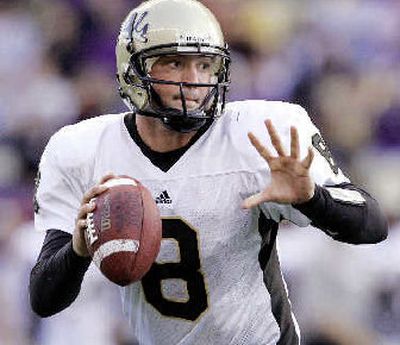Better by increments

University of Idaho football coach Nick Holt said it so often this season that one wondered if he was trying to convince himself the Vandals really were getting better.
So this should make Holt feel a little more secure. The 2005 Vandals were essentially a field goal per game better than in 2004.
Doesn’t sound like much, but it shows statistical support for Holt’s contention. The Vandals scored 1.7 points more per game in 2005 compared to 2004 and allowed 1.3 less. Holt was quick to point out tougher competition in the WAC and Idaho’s rash of injuries, particularly on offense.
“We improved a lot, tons,” Holt said of the 2-9 Vandals, who were 3-9 in 2004. “You can just tell by our games, not our win-loss record, but you come see us play from a year ago to this year.
“I see progress and kids getting better and working hard. When you see that, you build on those little battles.”
However, shortcomings remain on both sides of the ball. Statistically, the Vandals still lag behind former coach Tom Cable’s last season in 2003, when the team mastered the art of losing close games. The 2003 team was outscored by 5.5 points per game compared to 16 per game this season.
Holt believes quarterback Steven Wichman, who took over as the starter in the second game, provides big-play opportunities.
Wichman’s play fluctuated between stellar and suspect, often within the same game. He has an accurate arm and throws the deep ball well. However, he had a tendency to force passes, which resulted in 18 interceptions, and take sacks when he had time to throw the ball away.
“He gives us a chance,” Holt said. “The kids rally around him because he’s a competitor and he’s tough. He’s what you want in a quarterback.”
The 223-pound Wichman absorbed poundings against Hawaii, Fresno State and Boise State, but he proved durable. Holt said Wichman needs to continue learning the offense and station himself in the film room to study his play and opposing defenses.
Holt said he wonders how the offense would have performed had tight end Luke Smith-Anderson, running back Jayson Bird and a handful of offensive linemen stayed healthy. The 270-pound Smith-Anderson, who suffered a ruptured spleen in the preseason, has been a force in the passing game and is capable of blocking defensive ends. Bird, who broke his collarbone against UNLV in the second game, was consistent in 2004, averaging 5.7 yards per carry.
Without Bird, Idaho was one of the worst rushing teams in the nation until Tracy Ford provided a spark late in the season.
“We need depth,” Holt said. The injuries “were probably a blessing in hindsight because now we’ve created depth by (playing) a lot of kids that normally wouldn’t have played. We’re still a year or two away in recruiting.”
Idaho will pursue two high school quarterbacks and another running back or two. Chris Joseph and Brian Nooy are candidates for No. 2 quarterback.
The offensive line improved as the season went along but needs to become stronger physically. Redshirts Irvin Stevens and Adam Juratovac could be factors next season.
Holt said Jason Brown, who moved from defensive back to running back following Bird’s injury, will likely return to the secondary. Ford will probably stay at running back after seeing time as a receiver early on.
New receivers Daniel Smith, Matt Askew, Lee Smith, Wes Williams and Ford made an impact, despite issues with drops. Daniel Smith caught 67 passes, despite missing a game with a concussion. The freshman trio of Williams, Lee Smith and Ford should improve as they gain experience.
Still, Holt emphasized, Idaho needs more playmakers, with a heavy emphasis on speed. That applies to the defense as well, which must replace Cole Snyder at middle linebacker. Jaron Williams and Robert Davis are candidates in the middle. David Vobora and Josh Bousman often played in front of proven upperclassmen at the other linebacker spots.
The line loses tackle Jeff Edwards and end Mike Bonelli, but replacements appear ready to step in. Lewis and Clark graduate Josh Shaw saw considerable time as a true freshman. Ben Alexander made a successful transition from linebacker to end. Junior college transfer Charles Campbell showed impressive speed at end. Tackle Ryan Davis was productive, but Siua Musika and Alex Toailoa need to become consistent contributors.
The secondary returns cornerbacks Jason Martin and DeAngelo Ramsey. Holt expects Reggie Jones, who missed half the season for violating team rules, to return. Dan Dykes, Tone Tapule and Jevon Butler, who redshirted following the death of his mother, return at safety.
Recruiting priorities are linemen and defensive backs.
Kicker Mike Barrow bounced back from a rough 2004 season by making 16 of 19 field goals, including 7 of 8 from 40 yards and beyond. He also averaged 42.1 yards per punt filling in for T.J. Conley, who broke his leg near midseason. However, Idaho’s coverage units and return specialists were mediocre at best.
“Quite honestly the skill level of the top (WAC) teams was a lot better than the rest of us,” Holt said. “They’ve been around longer, but I thought we were all right there. We had a lot of difficulty with the top couple teams because they’ve got depth at defensive back and receiver. They have so much depth that they’re special teams are better.
“We do have some young guys with legitimate speed, we just don’t have enough of them.”
Idaho’s 2006 non-conference schedule includes Michigan State (5-6), Washington State (4-7) and co-Big Sky champ Eastern Washington (7-5). This year they played WSU, Washington (2-9) and UNLV (2-9).